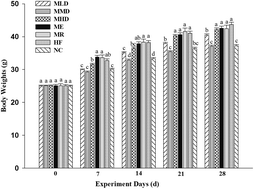The effects of the aqueous extract and residue of Matcha on the antioxidant status and lipid and glucose levels in mice fed a high-fat diet
Abstract
Matcha is a kind of powdered green tea produced by grinding with a stone mill. In the present study, the preventive effects of the aqueous extract (water-soluble) and residue (water-insoluble) of Matcha on the antioxidant status and lipid and glucose levels in mice fed a high-fat diet were investigated. Mice were fed seven different experimental diets for 4 weeks: a normal diet control (NC), a high-fat diet (HF), a high-fat diet with 0.025% Matcha (MLD), a high-fat diet with 0.05% Matcha (MMD), a high-fat diet with 0.075% Matcha (MHD), a high-fat diet with 0.05% Matcha aqueous extracts (ME), and a high-fat diet with 0.05% Matcha residues (MR). It was found that serum total cholesterol (TC) and triglyceride (TG) levels of the MHD group were significantly decreased compared to those of the HF group. Furthermore, in the MHD group, the level of high-density lipoprotein-cholesterol (HDL-C) was elevated, on the contrary the level of low-density lipoprotein-cholesterol (LDL-C) was suppressed. Moreover, Matcha could significantly lower the blood glucose levels, and improve the superoxide dismutase (SOD) activity and malondialdehyde (MAD) contents both in serum and liver; besides, the serum GSH-Px activity indicated that the oxidative stress caused by HF could be reversed by administration of Matcha. These findings suggest that Matcha has beneficial effects through the suppression of the blood glucose (BG) accumulation and promotion of the lipid metabolism and antioxidant activities. Moreover, the water-insoluble part of Matcha is suggested to play an important role in the suppression of diet-induced high levels of lipid and glucose.


 Please wait while we load your content...
Please wait while we load your content...